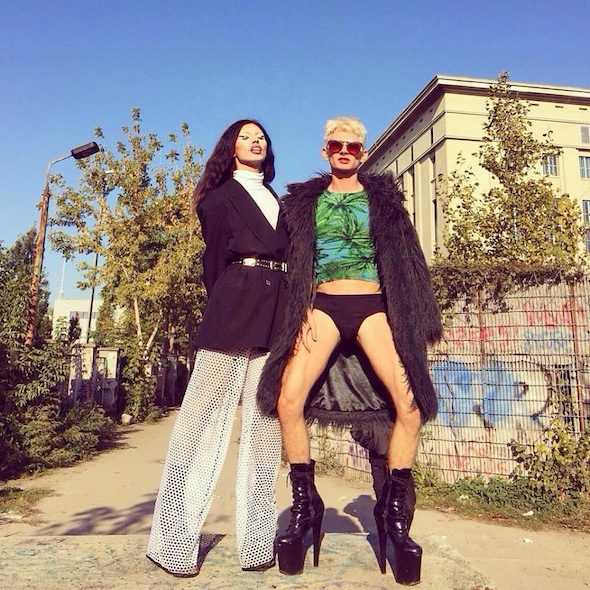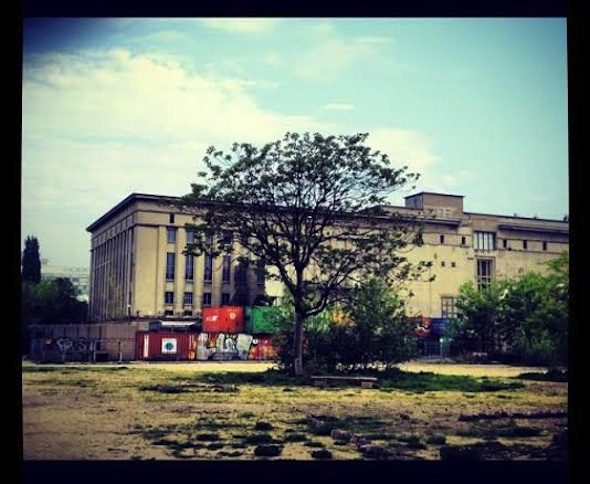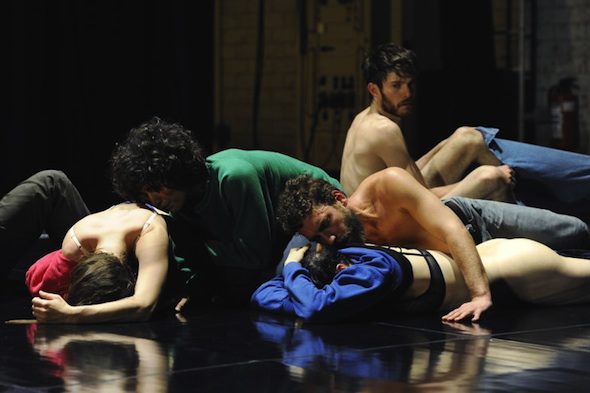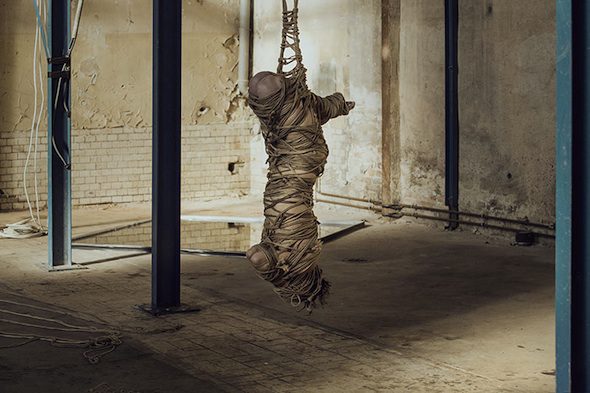This essay is part of an exchange between Revista ARTA online and Berlin Art Link. Editors Cristina Bogdan and Alison Hugill commissioned 3 texts each, on themes relevant to the art scenes of both cities. In the series, our contributors explore the socio-political nature of painting, music & performance, and DIY/underground art spaces in Berlin and Bucharest. All texts are published in both magazines, and are available in both English and Romanian.
Article by Göksu Kunak in Berlin; Wednesday, Oct. 28, 2015
 Mikey Woodbridge and Louie Banks, outside of Berghain; Photo by Paul Auls
Mikey Woodbridge and Louie Banks, outside of Berghain; Photo by Paul Auls
It’s thrilling to hear stories or watch films about divided Berlin, recognizing an extremely different Potsdamer Platz covered in dirt and dust. I recently visited the university I used to work at as a research and teaching assistant in Ankara, Turkey. One of my professors was studying in Berlin back in 1989. In a proud way, he reminisced about that day: November 9th, 1989. He was one of those, who broke down the Berlin Wall. While he was talking about the idiosyncracies of the city, he mentioned an artist with an empty shop on Oranienstrasse, where he used to live. Laden für Nichts (A Shop For Nothing) was written on the shop’s sign. He was shocked when I explained the impossibility of such a space now, a result of rising prices. Then we started to talk about the transitory nature of Berlin. A Turkish guy, for instance, immediately popped up with a mobile Döner-Imbiss near the ruins of the Wall the day after it fell, November 10th.
Within the notion of history, personal memories gain importance. It’s easier for ‘official’ historiography to erase certain scenes from collective memory. In Gabriel Garcia Marquez’s 100 Years of Solitude, one of the main characters attends a demonstration against the King. Suffering from a serious injury, the character is thought to be dead and put onto a train for deportation among other bodies. However, when he comes back to the village alive, no one remembers the violence that happened. Marquez’s story is a perfect example of history, memory and time constructed by the nation-state.
Chronopolitics − a term mostly associated with Paul Virilio’s writings on war, speed and vision − is basically the politics of time. The term is used to describe the geopolitics of three-dimensionality and the temporalization of space. In an era where the definition of geography has been changing as a result of digitalization, time gains more importance over space. According to heteronormative accounts, the past is created with the very idea of future and vice versa that forms the present. The superior position of he who knows time (Klinke) and a specific management of time negate the existence of other temporalities that exist.
 Berghain; Photo by Göksu Kunak
Berghain; Photo by Göksu Kunak
Is there room today for queer narratives that create a new notion of time outside of hetero-temporality? Queer uses of time and space develop a certain opposition to patriarchal institutions, such as nuclear families, heterosexuality and the biopolitics of reproduction. Recalling Halberstam’s theory of queer failure, some beings in society cannot succeed to perform what straight time expects from them. What is straight time? Theorists such as José Esteban Muñoz or Elisabeth Freeman explain it as the normalized rhythm and tempo that excludes the ones who cannot fit within the capitalist structure of movement – 9 to 5 jobs or schools; the so-called biological clock of women. Straight time never allows other possibilities of future. It moves from A to B without any exception. On the contrary, queer time, especially in the (non)spaces of theater and performance, or in queer spaces such as clubs and the BDSM scene, has the potential to generate a new way of exchanging knowledge, objects and bodies. As a result of the ephemerality of performance, even though it is not intended, the potential to leave the zone of straight time might appear. A restaging of heteronormative notions of time, space or the body creates a possibility and potentiality for polytemporality, spatiotemporality and hybridity. Dance and performance deconstruct and reconstruct the various codes of race, class, and gender displayed in normative regulations.
Perform polyamory on stage, twerk it; dance aimlessly!
During the transformation from modernism to postmodernism, postmodern dancers and choreographers such as Yvonne Rainer, Steve Paxton and Merce Cunningham, vigorously transformed the forms of ballet and modern dance by valuing spontaneity, daily simple acts. As Ramsay Burt also points out in his essays, a set of behaviors and codes of conduct that are generated through heteronormativity have easily found a place on stage in the realm of classical and modern dance. According to classical and modern choreography, everything should be on time, without allowing any kind of inchoateness: pontificating capital notions of time and professionality. Bodies are trained to accomplish high expectations. Gendered roles, movement patterns of ‘female’ and ‘male’ bodies, hierarchies of values and temporality, histories, memory and notions of time are being – (un)willingly or (sub)consciously – questioned by contemporary choreographers, dancers and performance artists such as Isabel Schad, Keith Hennessy, Meg Stuart, Jared Gradinger, Jeremy Wade, Boudry-Lorenz, Wu Tsang, Ming Wong, Trajall Harrell, Mette Ingvartsen, Julian Weber, Liz Rosenfeld, Fannie Sosa etc. On top of this, the anonymous dancers of Berghain should not be forgotten… Contrary to early waves in dance, contemporary dance and performance art allow failure – in terms of bodies and acts – and challenges accepted norms.
The aforementioned choreographers/artists and dancers of Berghain are contemporary queer freaks, who refuse to obey the authority of time and body codes. The pieces by these artists and queers form a new body of staging techniques. As Jose Esteban Munoz points out, this kind of performativity would allow new temporalities to appear. In his book Cruising Utopia: The Then and There of Queer Futurity (2009), Munoz longs for “a mode of being in the world that is also inventing the world” (121). The writer imagines a potentiality of ecstatic time that “is signaled at the moment one feels ecstasy, announced perhaps in a scream or grunt of pleasure” and contemplating on a scene from its past, present and future. By digging out what is forgotten or hidden in the narratives of the past, and critiquing the present, Munoz looks for a potentiality of a queer future of time – “no-longer-conscious” and “not‐yet‐here”.
 Meg Stuart/Damaged Goods – “UNTIL OUR HEARTS STOP”; Photo by Iris Janke
Meg Stuart/Damaged Goods – “UNTIL OUR HEARTS STOP”; Photo by Iris Janke
The Dark Entity – No Time
On one Berghain Sunday, while a man was walking around and gently whipping dancing people, a woman in a witch-like costume commanded attention. Although a basic rhythm was leading the clubbers, the woman was euphorically dancing to an asymmetrical rhythm, according to her own timing. Thanks to this kind of individuality and the inheritance of previous generations of freaks from the 1910s to the post-Wall period, Berlin can never be as hectic as London, or as posh as Paris. How has this city maintained its attractiveness and perversity for so long?
Even though lots of clichés linger in the air in terms of Berlin’s queer history, over the course of its existence, Berghain has become associated with “decadence and hedonism”. The architecture, lighting and music provide a space outside of time as we usually understand it. In comparison to heterotemporality, Berghain creates an ecstasy brought on by constant dancing. Reminiscent of a religious ritual, meditation or zikr, non-hetero sexual acts in the dark rooms also allow a unique mode of self-representation. By getting rid of an order of time, rejecting the codes of gender, the here and now disappears.
The queer dance scene and the rhythm of life in the queer club have a strong impact on choreographers and artists residing in Berlin. The Hain is a place of ritual and relaxation – while some do yoga, others do Berghain. The dance scene of Berghain opens a space for the perception of various temporalities that are far away from heterotemporality. The performances of anonymous dancers in the space, almost-perfect lighting, whips, dark rooms and fetish outfits produce a different sexuality from what is taught to us in mainstream society. Berghain is a dystopic-utopic entity.

 Martin W. Maier – “Diary Series” (2012-ongoing) ; Photo courtesy of the artist
Martin W. Maier – “Diary Series” (2012-ongoing) ; Photo courtesy of the artist
___________________________________________________________________


























